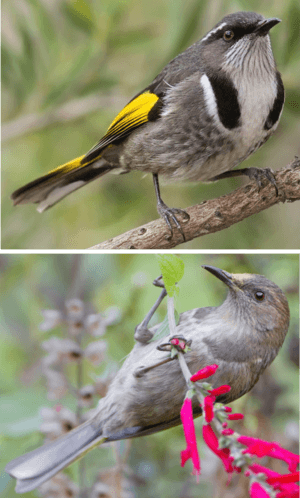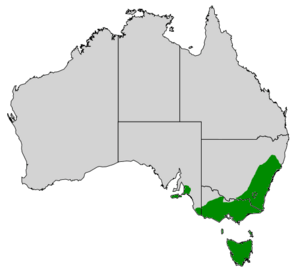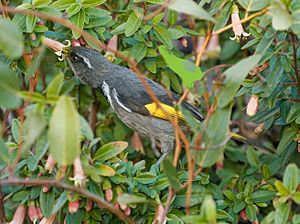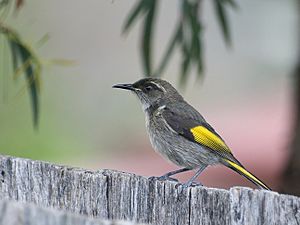Crescent honeyeater facts for kids
Quick facts for kids Crescent honeyeater |
|
|---|---|
 |
|
| Male (above) and female (below) | |
| Conservation status | |
| Scientific classification | |
| Genus: |
Phylidonyris
|
| Species: |
pyrrhopterus
|
 |
|
| Crescent honeyeater range | |
| Synonyms | |
|
|
The crescent honeyeater (Phylidonyris pyrrhopterus) is a small passerine bird. It belongs to the honeyeater family, called Meliphagidae. This bird lives in southeastern Australia. It is closely related to the New Holland honeyeater and the white-cheeked honeyeater.
This bird has dark grey feathers and lighter underparts. It has bright yellow patches on its wings. A wide, black crescent shape, outlined in white, runs down the sides of its chest. Males and females look a little different, with the female being less brightly colored. Young birds look like the female, but male baby birds can be told apart by their yellow wing patches.
Male crescent honeyeaters have a complex and varied song. They sing all year round from high places. During the breeding season, they even sing while flying. These birds live in thick forests, heathlands, parks, and gardens. They eat nectar from flowers and small invertebrates like insects. Crescent honeyeaters often form long-lasting pairs. They may even stay at the same nesting spot for many years. The female builds the nest and mostly cares for the two or three young. The young birds can take care of themselves about 40 days after the egg is laid.
Parent birds use different ways to protect their young from predators. However, baby birds can be eaten by snakes, kookaburras, currawongs, or cats. The crescent honeyeater faces some dangers, but there are enough of them for it to be listed as Least Concern for conservation. This means they are not currently at high risk of disappearing.
Contents
What is a Crescent Honeyeater?
The crescent honeyeater is a type of bird. It was first described in 1801 by a scientist named John Latham. He first thought it was related to treecreepers. Over time, it was given different names by other scientists.
The name Phylidonyris comes from French words for a honeyeater and a sunbird. The second part of its name, pyrrhopterus, comes from ancient Greek words. Pyrrhos means 'fire' and pteron means 'wing'. This refers to the bird's bright yellow wing patches.
Scientists recognize two types, or subspecies, of the crescent honeyeater. Most of them are the P. p. pyrrhopterus type. The other type, P. p. halmaturinus, lives only on Kangaroo Island and in the Mount Lofty Ranges in South Australia.
Studies of bird DNA show that the crescent honeyeater is closely related to the New Holland honeyeater and the white-cheeked honeyeater. These three birds form a small group called Phylidonyris. Other common names for this bird include chinawing and horseshoe honeyeater.
How to Identify a Crescent Honeyeater
Appearance
The crescent honeyeater is about 14–17 centimetres (5.5–6.7 in) long. Its wingspan is about 16–23 centimetres (6.3–9.1 in). It weighs around 16 grams (0.56 oz), which is about the same as a few coins.
Males and females look a bit different. This is called sexual dimorphism. The male is dark grey with bright yellow patches on its wings. It has a wide, black crescent shape, outlined in white, on the sides of its chest. There is also a white stripe above its eye. The top of its tail is black with yellow edges. This creates clear yellow areas on the sides of the tail. The underside of the bird is pale brownish-grey, becoming white.
The female is duller, more olive-brown. Her yellow wing patches are not as bright, and her crescent markings are less clear. Both male and female birds have dark grey legs and feet. They have deep red eyes and a long, curved black beak. Young birds look similar to adults but their markings are not as strong. They have dark grey beaks and duller brown eyes. Even when they are just seven days old, male baby birds can be identified by their brighter yellow wing patches.
The halmaturinus subspecies, found on Kangaroo Island, has paler feathers in females. Both males and females of this subspecies have smaller wings and tails but longer beaks.
Sounds and Calls
The crescent honeyeater makes many different musical sounds. They have alarm calls that sound like chattering. They also have short, sharp contact calls. The most common contact call sounds like a loud "e-gypt". Their alarm call is a quick "chip-chip-chip".
The male bird has a beautiful song that he sings all year long. This song is very complex and changes a lot. It includes a whistle that goes down in pitch and a musical two-note call. Males sing from high, open spots or hidden in the tree canopy. During the breeding season, they perform special "song flights" to attract mates. When the female is on the nest, the male sometimes sings soft, quiet notes nearby.
Where Crescent Honeyeaters Live

Crescent honeyeaters are found in different parts of southeastern Australia. You can find them in scattered groups in the Central Tablelands and Hunter Region of New South Wales. They are more common in areas south of Dharug National Park and east of Bathurst. In Victoria, they are widespread from the NSW border southwest to Wallan.
They are also common in Tasmania, except for the northeastern part where they are less common. In eastern South Australia, they live in sclerophyll forests. Small groups have been seen in the Mount Lofty Ranges and on Kangaroo Island. Sometimes, they move to new areas if their usual habitat changes.
Crescent honeyeaters live in many different places. These include coastal heathlands, rainforests, wet sclerophyll forests, and mountain forests. They like places with thick plants. They are often found in forests with eucalypt trees and a lot of shrubs underneath. At higher altitudes, they live in alpine heathlands and woodlands with small eucalypt trees.
We don't fully know how crescent honeyeaters move around. Many of them move to lower, warmer areas during the cooler months. However, some stay in the same place all year. For example, in southern Tasmania, they often move to city parks and gardens in autumn and winter. In the Sydney area, some birds move from the Blue Mountains to Sydney for winter. Other groups of crescent honeyeaters move around more, following where food is available. This has been seen in the Blue Mountains and parts of Victoria.
How Crescent Honeyeaters Behave

Breeding and Family Life
Crescent honeyeaters claim territories during their breeding season, which is from July to March. Pairs often stay in their territory even after the breeding season ends. They may use the same nesting spot for several years. Studies have shown that birds have been found near the same nest they were raised in, even almost ten years later.
These pairs nest alone or in small groups, with nests about 10 metres (33 ft) apart. The male bird protects the territory, which they use for finding food and raising young. During the breeding season, the male is very active in defending his area and sings a lot. To attract a mate, the male performs special song flights. He soars with shaky wings and makes a continuous high-pitched call.
The female builds the nest close to the edge of their territory, usually near water. The nest is deep and shaped like a cup. It is made from spiderwebs, bark, grass, twigs, and other plant materials. The inside is lined with soft grass, moss, and fur. They often use long strips of bark from stringybark trees.
A female usually lays 2 or 3 eggs, sometimes 4. The eggs are about 19 millimetres (0.75 in) by 15 millimetres (0.59 in). They are pale pink, sometimes with a hint of buff, and have lavender and chestnut spots. The spots are darker at the wider end of the egg. The female sits on the eggs to keep them warm and cares for the young. Both parents feed the baby birds and clean the nest. However, the female does most of the caring. Baby birds are fed insects, mostly flies. The eggs hatch after 13 days, and the young birds leave the nest after another 13 days. The parents feed the young birds for about two weeks after they leave the nest. The young birds become independent about 40 days after the egg is laid.
Parent birds use different ways to protect their young from predators. The female might stay on the nest until a predator is very close. One or both parents might pretend to be hurt, fluttering their wings on the ground to distract the predator. The female might fly quickly at the intruder. Both birds might make harsh scolding calls if a kookaburra, tiger snake, or currawong comes near. Crescent honeyeater nests are usually low in shrubs, which makes them easy targets for snakes and other birds. However, pet cats and wild cats are the most common predators of this bird.
Crescent honeyeaters often stay together in long-term pairs, sometimes for the whole year.
What Crescent Honeyeaters Eat
Crescent honeyeaters mostly live in trees. They find food among the leaves and flowers in the lower parts of trees and in the tree canopy. They eat nectar from flowers, fruits, and small insects. They have also been seen eating honeydew, which is a sweet liquid made by certain insects.
They mostly get food by poking their long beaks into flowers for nectar. They also pick insects off leaves and bark. Sometimes, they fly out to catch insects in the air. They are often seen feeding alone or in pairs. However, they can also gather in large groups when there is a lot of food available.
One study in Tasmania found that during the breeding season, their diet was all insects. In winter, nectar became a big part of their diet. They ate insects like moths and flies. They spent about two-thirds of their time looking for food on tree trunks and one-third on leaves. They eat nectar from plants that flower in autumn and winter. In spring, during breeding season, they feed on Tasmanian blue gum trees. Large numbers of crescent honeyeaters are attracted to royal grevillea flowers in subalpine areas during summer. When feeding on flame heath, they were seen visiting about 34 flowers every minute!
They also visit many other plants for food. These include different types of Banksia plants, waratah, and tubular flowers like Astroloma and Correa. They also feed on mistletoes and eucalypt trees. In Bondi State Forest, they were seen feeding on cluster-flower geebung, native holly, and silver wattle.
Protecting Crescent Honeyeaters
The crescent honeyeater is listed as a species of Least Concern for conservation. This means that there are enough of them, and they are not currently in danger of disappearing. However, their numbers have changed a lot over the last 25 years and seem to be going down now.
The biggest threats to crescent honeyeaters include losing their habitat. The alpine forests where they breed are being harmed by invasive weeds, big bushfires, dry weather, and land being cleared for other uses. Because crescent honeyeaters form long-term pairs and stay in the same breeding territories, their breeding success can be threatened if one partner dies or their home is destroyed.
When these birds move into cities, they are also at higher risk of accidents and being caught by predators. Cats have been seen hunting crescent honeyeaters. Because of this, some guides suggest that cat owners keep their cats inside or in outdoor enclosures.
See also
 In Spanish: Mielero alafuego para niños
In Spanish: Mielero alafuego para niños



